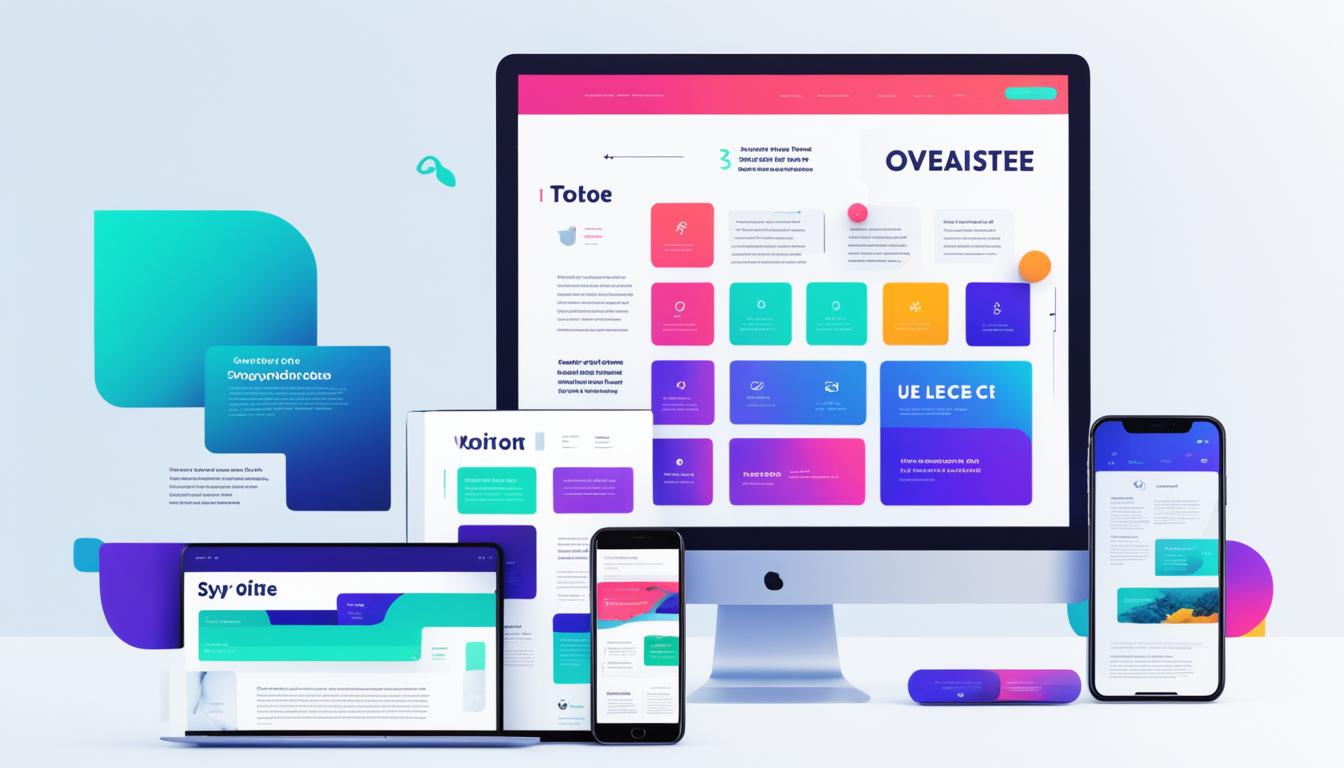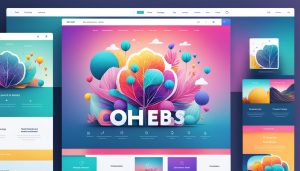Latest Web Design & UX Design Articles in 2024
Did you know that in 2024, the field of web design and UX design is undergoing exciting changes and advancements?
As technology continues to evolve, so do the expectations and demands of users. Websites are no longer just digital portals but have become immersive experiences that captivate and engage visitors. To stay ahead of the curve, designers need to embrace the latest web design trends, user experience design tips, and innovative ideas to create cutting-edge and user-friendly websites.
In this article, I will explore the key trends and techniques shaping web design and UX design in 2024. From responsive web design techniques to mobile-friendly design strategies and interactive website design trends, we will delve into the exciting world of digital experiences. So, let’s dive in and discover the future of web design and UX design!
Key Takeaways:
- Stay updated on the latest web design trends to create visually stunning and engaging websites.
- Implement responsive web design techniques to ensure your websites adapt seamlessly to different devices.
- Prioritize user experience design by incorporating best practices and user-centric design principles.
- Embrace innovative web design ideas to create unique and memorable digital experiences.
- Create mobile-friendly designs to cater to the growing number of mobile users.
Late-Stage UX and the Characteristics
Late-stage UX, similar to late-stage capitalism, is characterized by market saturation, a focus on financial growth, automation, commoditization, and increased financialization. AI is automating a significant portion of design tasks, reducing the demand for designers in certain markets. The supply of designers has also outstripped demand, leading to uncertainty in the market.
There is a shift towards scalability and standardization over differentiation and delight in design, driven by the influence of financial health, shareholder interests, and business metrics. The lack of trust in digital products has resulted in users being skeptical, complacent, or susceptible to exploitation.
Designers in 2024 need to navigate these challenges and find ways to advocate for user needs within this landscape.
In the era of late-stage UX, market saturation, automation, commoditization, and financialization have become prominent features, mirroring the dynamics of late-stage capitalism. These traits shape the current landscape of UX design, presenting both challenges and opportunities for designers.
With the rise of AI, an increasing number of design tasks are being automated, diminishing the demand for human designers in certain sectors. This automation, coupled with the oversupply of designers, has created a sense of instability and uncertainty within the job market. Designers must adapt to this shifting landscape by leveraging their skills and finding ways to differentiate themselves from automated solutions.
In addition to automation, financial interests and metrics are exerting a strong influence on design decisions. Businesses prioritize scalability and standardization, often at the expense of differentiation and user delight. This focus on financial growth and business metrics can lead to a lack of trust in digital products, leaving users skeptical and complacent.
Despite these challenges, designers have the opportunity to advocate for user needs and human-centered design within late-stage UX. By staying informed of industry trends, embracing user research and empathy, and consistently advocating for the user experience, designers can create meaningful and impactful designs that stand out in a saturated market.
It is crucial for designers to understand the characteristics of late-stage UX and adapt their skills and strategies accordingly. This includes developing expertise in areas beyond traditional design tasks, such as UX research, strategy, and conceptual design. By broadening their skill set and staying ahead of industry trends, designers can find new opportunities and navigate the complexities of late-stage UX.
The Role of AI in Design
AI is revolutionizing the design industry, influencing both organizational practices and self-service design platforms. With the advent of Generative AI and Large Language Models (LLMs), corporations are able to streamline their design processes and decrease dependence on manual tasks. As a result, we are seeing smaller design teams as AI takes on these repetitive responsibilities.
Self-service design platforms such as Wix, Squarespace, Canva, and Envato are now providing users with the ability to design and launch websites effortlessly. These platforms leverage AI-driven personalization, empowering small business owners to create professional-looking designs without the need for extensive design skills.
While AI is automating certain design tasks, it is essential for designers to cultivate skills that are complementary to AI capabilities. UX research, UX strategy, and conceptual design will become increasingly critical in the design landscape. This signifies the importance of designers adopting a strategic mindset and purposeful decision-making when utilizing AI in design tools.
While AI continues to evolve and shape the design field, it’s important to recognize that AI is a tool that should augment the designer’s unique perspective and expertise. AI can facilitate the design process and automate certain aspects, but it is the designer’s creativity, intuition, and strategic thinking that ultimately sets them apart.

By embracing AI and being mindful of its capabilities, designers can effectively navigate the rapidly changing design landscape and leverage AI as a valuable tool. Whether it’s collaborating with AI-powered platforms or developing expertise in prompt engineering, designers can prepare themselves for a future where AI is ubiquitous in design and seamlessly integrated into all apps and devices.
Navigating Saturation and Shrinking Teams
In the design job market of 2024, designers are facing challenges due to market saturation and instability. These factors have led to layoffs, limited design resources, and an increase in outsourcing. As a result, designers may feel a decline in their bargaining power within their organizations and struggle to find positions that align with their skill sets.
However, this situation also presents an opportunity for designers to reassess their career paths and explore new avenues. By tapping into their professional networks and venturing into different industries and problem spaces, designers can adapt to the changing landscape and find fresh opportunities.
One positive aspect of leaner design teams is that individual designers have more accountability and visibility. With smaller teams, designers become responsible for delivering value and demonstrating their impact within their organizations. This increased accountability can be a chance for designers to showcase their skills and expertise, and highlight their contribution to the overall success of a project.
While the current design job market poses challenges, the allure of design challenges and opportunities remains strong. Designers need to find ways to spark excitement about their craft and explore new avenues for growth within their organizations. By staying proactive, adaptable, and open to new possibilities, designers can navigate through the saturation and shrinking teams to carve out fulfilling career paths.

| Challenges | Opportunities |
|---|---|
| Layoffs | Reassess career paths |
| Limited design resources | Tap into professional networks |
| Increased outsourcing | Explore different industries and problem spaces |
| Decline in bargaining power | Showcase skills and expertise within organizations |
| Find new avenues for growth |
The Importance of Accessible Design and Cross-Platform Experiences
In 2024, I believe that accessible design and cross-platform experiences will be vital aspects of creating inclusive and seamless user experiences. As designers, it is our responsibility to ensure that our designs are accessible to users with diverse needs and disabilities. By implementing features such as voice commands, familiar gestures, alternative text, closed captions, and adjustable font sizes, we can guarantee equal access and participation for everyone.
Cross-platform experiences are also crucial in today’s digital landscape. With users accessing websites and applications on various devices, from smartphones to smart TVs and wearable devices, it is important to provide consistent interactions and user interfaces across all platforms. To enhance the memorability and usability of our designs, we can experiment with deconstructed hero sections, off-white aesthetics, and innovative cursor interactions. These elements can make our designs stand out and create a lasting impression on users.
Data visualization techniques will continue to be essential in simplifying complex datasets and effectively communicating insights. By utilizing engaging and interactive data visualization methods, we can help users understand and interpret information more easily. Additionally, the rise of AR/VR immersive experiences will revolutionize the way users interact with digital content, bridging the gap between the real and virtual worlds.
To create impactful and user-centered designs in 2024, we must prioritize accessibility, seamless cross-platform experiences, and engaging data visualization techniques. By considering the diverse needs of our users, providing consistent interactions across different devices, and effectively communicating complex data, we can create designs that leave a lasting impact and provide a delightful user experience.
FAQ
What are some web design trends to look out for in 2024?
How is AI impacting the field of design?
How can designers navigate the challenges of saturation and shrinking teams?
Why is accessible design important in web design?
How can designers create cross-platform experiences?
- Shop for Server & Workstation Systems & more - February 25, 2025
- IP Geolocation API and IP Location Lookup Tools - February 24, 2025
- What is GoDaddy? Everything You Need to Know in 2024 - February 23, 2025





















Post Comment
You must be logged in to post a comment.